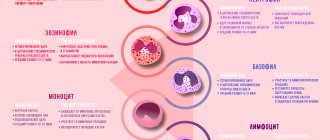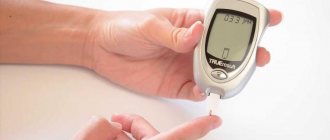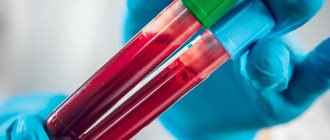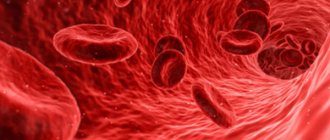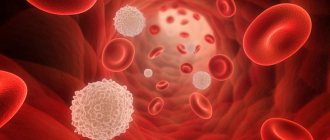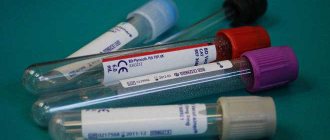This helps to detect the disease in advance and begin treatment in the initial stages. Diabetes, missed at an early stage, will follow the rapid development of more aggravating forms, as a result of which the body performs processes that can no longer be corrected.
When referring for a blood sugar test, it means confirming the level of glucose in the blood, since it is this that nourishes all our cells in the body and supplies it with energy.
What is the role of glucose in the body?
Glucose is a supplier of “fuel” for the body.
A good indicator for sugar levels is from 3.3 to 5.5 mmol/l. When indicators shift from normal values, endocrinological diseases progress in a person.
A blood sugar test is simple, but provides detailed information on glucose levels.
Glucose levels should be maintained within normal limits, because with pathologies and certain characteristics of the body, its level can fluctuate in one direction or another, which threatens health and even life.
Glucose levels should be maintained within normal limits, because with pathologies and certain characteristics of the body, its level can fluctuate in one direction or another, which threatens health and even life.
Procedures for donating blood for GTT
Taking a blood sugar test with a load is quite simple, but it takes a long time, since the test lasts 2 hours, after which it will be clear whether carbohydrate metabolism is normal or not. Based on its results, the doctor will understand how the body’s cells react to insulin and make a diagnosis.
The glucose tolerance test takes place in several steps:
- To begin with, the patient receives directions from his doctor to donate blood for sugar and the procedure is performed strictly on an empty stomach. Experts advise not to eat anything for no more than 12 hours, as otherwise the results will be inaccurate. It is for this reason that tests must be taken early in the morning;
- The next step is the load itself, and for this the patient will have to drink a glucose solution diluted in water. You can prepare it by taking 75 grams of special sugar per glass of water (250 ml), and if it comes to pregnant women, the amount can increase to 100 grams. For children, the concentration is slightly different, because they need to take 1.75 g. per 1 kg of their weight, but the total amount of glucose should not exceed 75 g. If the intravenous method of administration was chosen, then this procedure will be carried out using a dropper for 5 minutes. You can buy glucose at any pharmacy where it is sold in powder form;
- An hour after drinking sweet water, the patient's blood will be taken for analysis to find out how much the blood sugar level has increased. After another 1 hour, there will be a control sampling of biomaterial, in which it will be seen whether the person has disruptions in carbohydrate metabolism or everything is normal.
A glucose tolerance test will make it possible to find out how quickly the patient’s body can absorb the resulting glucose and the final diagnosis will depend on this. If the pancreas produces little insulin or it is poorly accepted by the body's cells, then the sugar concentration will remain quite high throughout the test. Such indicators indicate the presence of diabetes or a pre-diabetic state, since in a healthy person, after an initial sharp jump in glucose, everything quickly returns to normal.
If the doctor has previously announced his verdict, then you should not be upset in advance, because such a test must be taken 2 times.
The load is carried out a second time after a few days and there have been cases when it was performed 3 and 4 times. This was done due to factors that distorted the test results, but if 2 tests in a row show numbers close to each other, then the endocrinologist will make a final diagnosis.
Why take a blood sugar test for people of any age?
Diabetes mellitus affects people all over the globe. Detecting it in the early stages is essential for applying therapy for recovery. A doctor can detect diabetes through a clinical blood test or other examinations of the patient.
Blood is donated for sugar levels in the following cases:
- Suspicion of possible diabetes mellitus,
- Before operations that take place under anesthesia,
- In patients suffering from atherosclerosis and coronary heart disease,
- Just as part of a laboratory analysis,
- To control therapy in case of diabetes,
- People at risk (pancreatic diseases, people with obesity and heredity),
What is a glucose tolerance test?
The glucose tolerance test can have two main types - taking glucose orally and administering the necessary substance in the form of an intravenous injection.
Blood is given to determine the sugar level under load in order to find out how quickly the studied parameters returned to normal limits. This procedure is always carried out after blood sampling on an empty stomach.
Typically, a glucose tolerance test is taken by consuming the required amount of diluted glucose in the form of syrup (75 grams) or tablets (100 grams). This sweet drink must be drunk to obtain reliable results on the amount of sugar in the blood.
In some cases, glucose intolerance occurs, which most often manifests itself:
- in pregnant girls during severe toxicosis
- in the presence of serious problems of the gastrointestinal tract.
Then the second diagnostic method is used for analysis - intravenous administration of the required substance.
There are factors that do not allow the use of this diagnosis. Such cases include the following contraindications:
- Allergic reactions to glucose occur.
- The development of infectious diseases in the body.
- Exacerbation of diseases of the gastrointestinal tract.
- The course of inflammatory processes in the body
Expert opinion
Shalaeva Svetlana Sergeevna
endocrinologist, highest category, 18 years of experience
In addition, recent surgical intervention is a contraindication.
Clinical picture
According to Decree No. 56742, every diabetic can receive a unique remedy at a special price!
Doctor of Medical Sciences, Head of the Institute of Diabetology Tatyana Yakovleva
I have been studying the problem of DIABETES for many years. It's scary when so many people die and even more become disabled due to diabetes.
I hasten to report good news - the Endocrinological Research Center of the Russian Academy of Medical Sciences managed to develop a medicine that completely cures diabetes mellitus. At the moment, the effectiveness of this drug is approaching 100%.
Another good news: the Ministry of Health has achieved the adoption of a special program under which the entire cost of the drug is compensated. In Russia and the CIS countries, diabetics up to
On July 6th they can receive the product -
FREE!
Find out more>>
What symptoms are alarming?
If you notice obvious symptoms, you should go to the hospital:
- Fast weight loss,
- Stable fatigue
- Decreased vision
- An inexhaustible feeling of thirst,
- Frequent processes of urination,
- The wounds don't heal well
- The presence of dryness in the oral cavity (and all mucous membranes).
If you notice at least one of the signs, you need to contact a competent endocrinologist and take a blood test for sugar.
The risk zone also includes healthy people who are at risk of diabetes progression. They should carefully observe nutrition and a healthy lifestyle, remove themselves from heavy loads and frequent stress. It is also worth regularly taking a blood test for sugar.
People at risk include:
- Those whose close relatives had this diagnosis,
- Obese
- Stable users of glucocorticoids,
- With allergic diseases (eczema, neurodermatitis),
- Those who develop cataracts, hypertension, angina pectoris, atherosclerosis before the age of 40-50,
- With a tumor of the adrenal gland or pituitary gland.
In childhood, there is a variant of type 1 diabetes; it is important for parents to monitor for the slightest signs of diabetes. The diagnosis must be made by a doctor after sending the child for a blood sugar test. Children have slightly changed normal sugar levels, ranging from 3.3 to 5.5 mmol/l.
Type 1 diabetes is characterized by:
- Increased craving for sweets,
- Fatigue several hours after meals.
Increased attention to fluctuations in blood sugar levels should be observed during pregnancy. The body of the expectant mother, in connection with the appearance of the fetus, works at an accelerated pace, which sometimes causes deviations that provoke diabetes. In order to detect pancreatic disorders in time, pregnant women are sent for a blood sugar test.
It is especially important for women who have diabetes before conception to monitor their blood glucose levels.
How to dilute glucose for sugar analysis
To carry out this analysis, dry glucose is used, diluting it with water. The dosage of glucose for a sugar test is determined by a medical specialist, depending on the gender and age of the patient.
For children, a solution is usually used at the rate of 1.75 g of dry glucose per 1 kg of weight. The standard dosage is 75 grams, administered orally or through an IV. For pregnant women, the dose can be increased to 100 g.
It is worth noting that a stress blood test takes longer than usual (about 2-2.5 hours): after the patient has consumed a glucose solution, blood is taken from a vein every half hour for analysis.
Due to the fact that the solution is very sweet, nausea and vomiting are possible - in this case, the analysis is scheduled for another date.
What are the causes of blood sugar instability?
Diabetes mellitus is not necessarily the cause of increased blood glucose levels.
Some body conditions also cause an increase in sugar:
- Epilepsy,
- Use of certain medications
- Eating food before tests
- The influence of toxic substances (optionally, carbon monoxide),
- Physical overexertion,
- Emotional stress.
Low blood sugar levels are observed as often as high blood sugar levels.
Low sugar occurs when:
- Obesity,
- Prolonged fasting
- Tumors in the pancreas,
- Nervous system disorders
- Liver diseases,
- Alcohol poisoning,
- Taking insulin in excess of the prescribed dose, for patients with diabetes,
- Vascular diseases,
- Poisoning with poisons.
Sugar level
The place of the method in the diagnosis of the disease
To clarify the patient’s condition, if an illness is suspected, there is a certain sequence in which studies are prescribed.
Table No. 1. Tests necessary to diagnose the disease:
| Name of the study | Its purpose and features |
| A simple blood glucose test | Allows one-time measurement of fasting sugar levels |
| Load glucose test | Makes it possible to compare the indicators on an empty stomach and after drinking a sweet liquid - load |
| Analysis for glycated hemoglobin | The study, which is carried out over a long period of time - up to two months, demonstrates the condition of the blood during a more detailed study |
| C-peptide test | This method will help determine the type of diabetes and prescribe the correct treatment. |
| Test for antibodies to pancreatic tissue | Another way to understand what type of diabetes has attacked the patient is to understand whether there is an autoimmune reaction of the body against its own pancreas |
This is not a complete list of diagnostic procedures that help clarify the patient’s condition and alleviate the condition with proper therapy and targeted lifestyle correction.
How to prepare for a blood sugar test?
By following simple rules, you can ensure accurate test results:
- 10-12 hours before the test, limit yourself to eating,
- Try not to get into stressful situations and do not perform difficult physical activities the day before,
- Avoid cigarettes before getting tested
- 24 hours before the test, do not drink alcohol,
- If you are taking any medications, you should inform your doctor.
- Before taking the test, do not brush your teeth or chew gum.
Preparing for analysis is not difficult, but it is important, take it seriously.
Where is blood taken from?
Blood is drawn from a finger (less often from a vein).
Types of blood sugar tests:
To fully determine your blood sugar level, the endocrinologist will refer you to a clinical blood test. Based on the results of this examination, he will prescribe insulin and treatment.
In medicine, there are 4 types of blood glucose tests (2 basic and 2 clarifying) (Table 1):
Table 1
| Basic methods | Clarifying methods |
| Laboratory (biochemical) method | Analysis for glycated hemoglobin |
| Express method | Test with sugar “load” |
What kind of analysis?
The study is carried out in a clinical laboratory. Preparation for it is more rigorous and thorough than for conventional analysis. The glucose tolerance test helps to recognize hidden disorders of carbohydrate metabolism and diagnose diabetes mellitus. The study will allow you to detect this disease in a timely manner and receive the necessary treatment.
Indications
A blood sugar test with a load helps to recognize the disease. Excess glucose indicates the likelihood of diabetes. This verification is also used to monitor the progress of treatment. Testing is also necessary during pregnancy or if there are risk factors for the disease:
- diabetes mellitus type 1 and 2;
- additional testing to clarify the diagnosis, in addition, for the gestational type in pregnant women;
- disease of the digestive tract and pituitary gland;
- polycystic ovary syndrome;
- abnormalities in liver function;
- presence of vascular diseases;
- epilepsy;
- pathologies of the endocrine glands;
- endocrine disruptions.
Preparation
It is very important to remember the basic rules of preparing for the test. To find out the most correct results, preparation must be carried out correctly:
Before donating blood for analysis, you need to eliminate fatty and fried foods for a couple of days.
within three days before the analysis, the patient must include in his diet food containing a sufficient amount of carbohydrates, excluding fried and fatty foods;- It is not recommended to eat food 8 hours before the procedure;
- drink only still water;
- 2-3 days before the test, do not take medications;
- one day before the test you should not drink alcohol or smoke;
- Only moderate physical activity is recommended;
- You should not donate blood after undergoing an ultrasound, x-ray or physical therapy.
If it is unacceptable to stop taking medications, you need to inform your doctor
Standard laboratory method
Such an analysis will most likely correctly show whether there is diabetes in the blood or whether it is absent. Blood donation occurs most often from a finger (possibly from a vein). Blood is taken from a finger if the analysis is biochemical, and the blood test will be carried out by an automatic analyzer.
Express test
This test helps you measure your blood glucose levels without leaving your home. However, the error of such a test can be up to 20%, due to the fact that the test strips deteriorate over time when exposed to air.
The procedure for measuring with the express test:
- Treat the skin puncture site with alcohol or antiseptics,
- We make a puncture in the area of the finger pad,
- Remove the first drop with sterilized cotton wool or a bandage,
- Place the second drop on the test strip, installed in advance in the device,
- Let's look at the results.
Sugar. Norm and deviations.
Glucose tolerance test (load)
If the laboratory method reveals that sugar levels are normal, then, to make sure that the body is not prone to diabetes, doctors recommend taking a stress test. This study is carried out if the endocrinologist suspects the early stages of diabetes mellitus or problems with carbon metabolism. How does this test work?
Over the course of two hours, blood is drawn from the subject 4 times. The first approach is done in the morning, on an empty stomach. Then the person being studied must take water with glucose (70-110 grams, stirred in 150-200 ml of water). Blood samples are taken after 1 hour, 1.5 and 2 hours. You cannot eat or drink during the entire analysis.
Doctors observe how blood sugar behaves: after taking glucose, it rises and then gradually decreases.
As a result of such a test, there are normal indicators:
- 7.8 mmol/l is normal,
- from 7.8 to 11.1 mmol/l - means that the patient is in a state of prediabetes,
- more than 11.1 mmol/l – diagnosis of diabetes.
Glucose tolerance test during pregnancy
The glucose load test is an important diagnostic sign for the development of diabetes mellitus in a pregnant woman (gestational diabetes mellitus). In most antenatal clinics, it was included in the mandatory list of diagnostic measures and is recommended for all pregnant women, along with the usual determination of fasting blood glucose levels. But, most often, it is performed for the same indications as for non-pregnant women.
Due to changes in the functioning of the endocrine glands and changes in hormonal levels, pregnant women are at risk for developing diabetes. This condition poses a threat not only to the mother herself, but also to the unborn child.
If there is a high level of glucose in a woman’s blood, then it will certainly enter the fetus’s body. Excessive amounts of glucose lead to the birth of a large baby (over 4–4.5 kg), a tendency to diabetes and damage to the nervous system. Very rarely there are isolated cases when pregnancy can end in premature birth or miscarriage.
Tolerance testing is carried out in the second trimester of pregnancy and has its own characteristics. First, blood is drawn three times. The first time on an empty stomach, the second time 1 hour after drinking a glucose solution, the third time 2 hours after a glucose tolerance test. Secondly, the first time they examine blood from a finger, and the other 2 times – venous blood.
A breakdown of the obtained test values is presented below.
What does a glycated hemoglobin test give?
Such an analysis, of a biochemical nature, shows the average blood sugar level for up to three months. It is prescribed for the effectiveness of insulin treatment or to confirm the diagnosis of diabetes.
Glycated hemoglobin combines with glucose molecules forever. If the sugar level is elevated (diabetes mellitus), the reaction occurs much faster than normal and leads to an increase in the level of such hemoglobin in the blood.
Blood sampling for this test is carried out from a finger, regardless of food intake.
This analysis shows the effectiveness of insulin treatment in recent months.
The normal level of glycated hemoglobin is from 4 to 9%.
Exceeding the norm leads to the likelihood of complications. And if the indicator is more than 8%, this indicates that the therapy should be changed, since it is not effective.
Indications for testing
Glucose tolerance testing is a test to determine the extent to which peak secretion of the hormone insulin is impaired.
Its use is relevant for identifying hidden failures in the process of carbohydrate metabolism and incipient diabetes mellitus.
It is recommended that apparently healthy people (including children) under the age of 45 undergo a GTT test every three years, and annually at older ages, since detection of the disease at an early stage is most effectively treated.
Glucose tolerance testing is usually recommended by specialists such as a therapist, endocrinologist and gynecologist (less often a neurologist and dermatologist).
Patients undergoing treatment or examination are referred if they have been diagnosed with or noted the following disorders:
- obesity;
- suspicion of type 2 diabetes to confirm it;
- selection or adjustment of the course of treatment for type 2 diabetes;
- presence or suspicion of gestational diabetes;
- type 1 diabetes mellitus (for self-control);
- metabolic syndrome;
- prediabetes;
- impaired glucose tolerance;
- disturbances in the functioning of the pancreas and adrenal glands;
- disturbances in the functioning of the liver and pituitary gland;
- other endocrine diseases.
Persons suffering from the above ailments and sent to take the GTT test must follow certain rules during preparation so that the interpretation of the results is as accurate as possible.
Preparation rules include:
- Before testing, the patient must be carefully examined for the presence of diseases that can affect the result values;
- for three days before the test, the patient must follow a normal diet (exclude diets) with a mandatory carbohydrate intake of at least 150 g per day, and also not change the level of normal physical activity;
- within three days before the test, you should exclude the use of medications that can change the actual analysis parameters (for example: adrenaline, caffeine, contraceptives, diuretics, antidepressants, psychotropic drugs, glucocorticosteroids);
- within 8-12 hours before the test, you should avoid eating and drinking alcohol, and also not smoke. However, abstaining from food for more than 16 hours is also contraindicated;
- The patient must be calm when taking the sample. He should also not be exposed to hypothermia, exercise, or smoke;
- The test cannot be performed during stressful or debilitating conditions, as well as after them, after operations, childbirth, with inflammatory diseases, hepatitis and cirrhosis of the liver, during menstruation, with impaired absorption of glucose in the gastrointestinal tract.
During the test, laboratory technicians draw blood on an empty stomach, after which glucose is injected into the test subject's body in one of two ways: orally or intravenously.
Typically, adults are given a solution to drink in a ratio of glucose and water in the amount of 75 g/300 ml, with another 1 g added for every kilogram of weight over 75 kg, but not more than 100 g.
For children, the ratio is 1.75 g/1 kg of weight , but should not exceed 75 g.
Administration of glucose through a vein is used exclusively in cases where the patient is physically unable to drink a sweet solution, for example, with severe toxicosis of a pregnant woman or with gastrointestinal disorders. In this case, glucose is dissolved at the rate of 0.3 g per 1 kg of body weight and injected into a vein.
After administering glucose, another blood sugar test is performed according to one of two schemes:
- classical , in which samples are taken every 30 minutes. within 2 hours;
- simplified , in which blood is drawn after one hour and two hours.
What is the connection between sugar and cholesterol?
Doctors and researchers have long discovered the relationship between glucose and cholesterol in the blood.
This happens because the norms of these indicators are influenced by the same factors, such as:
- Poor nutrition
- Obesity,
- Passive lifestyle.
The values of cholesterol and blood glucose in the adult population are similar. Normal blood sugar levels range from 3.3 to 5.5 mmol/L, and normal blood cholesterol levels range from 3.6 to 7.8 mmol/L.
Interpretation of results
The second and third fences are made from a finger.
The obtained figures can be compared and conclusions can be drawn. Now the doctor can confirm the hypothesis of the presence of diabetes or reject it, this opportunity is provided by a stress blood sugar test. The norm for each measurement will be different.
Table No. 2. Interpretation of results:
| Result | Indicator on an empty stomach | Indicator with load, after two hours |
| Hypoglycemia | Up to 3.3 mmol/l | Up to 3.3 mmol/l |
| Norm | From 3.3 to 5.6 mmol/l | Not more than 6.8 mmol/l |
| Prediabetes | From 5.6 to 6 mmol/l | From 6.8 to 9.9 mmol/l |
| Diabetes | More than 6.1 mmol/l | More than 10 mmol/l |
If the result of a blood sugar test with a load, the norm of which is strictly defined, does not deviate significantly upward, this often indicates the initial stage of the disease. When borderline values are identified in young people under 25 years of age, it is worth doing a genetic analysis to exclude the subtype of diabetes typical of young people with a genetic disorder.
Important: all results can be correctly interpreted only by an endocrinologist, who should be involved in the treatment of the disease.
For treatment, it is worth choosing a long-term specialist whom you want to trust.
If the blood sugar norm is not met under load, this indicates problems with carbohydrate metabolism - the body is not able to fully utilize sugar from the bloodstream and use it for the needs of the body, which needs energy. recharge.
The cause of this problem can be different - insensitivity of body tissues to insulin, lack of the hormone, an autoimmune reaction to pancreatic cells, genetic abnormalities. The task of load analysis is to identify the problem so that the specialist can begin to help the patient.
Decoding of the analysis and norm
After you have taken a blood sugar test and the laboratory has conducted research, you will be given the test results. In order not to fall into despair from incomprehensible numbers, let's decipher them together.
To do this, we use a table in which the results of blood tests for sugar are deciphered (Table 2):
Table 2
| Name of analysis | Laboratory analysis | Test with sugar “load” | Analysis for glycated hemoglobin |
| Normal values mmol\L | 3,5 – 5,5 | First sample – 3.5 – 5.5, | Less than 5.7% |
| After taking glucose, less than 7.8 | |||
| Indicators for diabetes, mmol/l | 6.1 or more | The first sample is more than 6.1, | More than 6.5% |
| After taking glucose more than 11.1 | |||
| Value for prediabetes, mmol/l | 5,6 – 6,1 | First sample 5.6 – 6.1, | 5,7 – 6,4% |
| After taking glucose 7.8 – 11.1 | |||
| Values for hypoglycemia, mmol/l | Less than 3.5 | Less than 3.5 | — |
It is worth remembering that the norm is almost the same for children and adults, but for older people it is higher.
Blood glucose level
The blood sugar levels in men and women are no different. The interpretation of the analysis of material taken from capillaries and from a vein differs by approximately 12% (in the latter case the norm is higher). For children and adults, normal sugar levels are in different ranges. The unit of measurement is mmol/l. In some medical institutions, sugar levels are measured in other units (mg/100 ml, mg% or mg/dl.). To convert them to mmol/l, the numbers need to be reduced by 18 times. When conducting a biochemical study, this indicator is deciphered as Glu or “glucose”.
In adults on an empty stomach
The glucose norm for adults is in the range of 3.3–5.5 units for material taken from capillaries (from a finger). For blood taken from a vein, the norm falls within the range of 3.7 to 6.1 units. The interpretation of the analysis indicates prediabetes with values of up to 6 units (up to 6.9 for blood taken from a vein). The diagnosis of diabetes mellitus is made when the “norm” value changes above 6.1 for capillary blood and above 7.0 for venous blood.
Prediabetes is a borderline condition that has several other names: impaired glucose tolerance or impaired fasting glucose.
In adults after eating
Sometimes you have to donate blood on an empty stomach, then the normal sugar level ranges from 4 to 7.8 units. A change in this value up or down requires additional examination or re-testing.
In children on an empty stomach
In children from birth to the age of 1 year, the normal blood sugar level (finger test) is in the range of 2.8–4.4 units. A blood sugar test is considered normal at a level of 3.3–5.0 units for children from one to five years of age. For children over 5 years old, the norm is the same as for adults. Indicators indicate diabetes mellitus when their value is above 6.1 units.
In pregnant women
In women in an “interesting” position, malfunctions often occur in the body, so the normal values of some tests are slightly within different limits. These indicators include blood sugar. The norm for pregnant women falls within the range of 3.8 to 5.8 units for capillary blood. If the indicator changes above 6.1 units, additional examination is required.
Sometimes a condition of gestational diabetes is observed. This period often occurs in the second half of pregnancy and ends some time after birth. In some cases, this condition develops into diabetes mellitus. Therefore, pregnant women must take a blood test for sugar throughout the entire period of pregnancy and for some time after the child is born.
How to lower your blood sugar the night before your test?
You can lower your blood sugar level on the eve of the test by following a diet: low-fat yoghurts and kefir, non-sweet fruits, cheeses, fresh vegetables, as well as non-fatty meats - fish, chicken, chicken. You should stop eating at least 12 hours before the test.
During these 12 hours, our liver burns sugar. Active and vigorous exercise can also lower blood sugar levels.
To lower it, insulin is also injected under the skin, but only on the recommendation of a doctor, otherwise it can lead to coma and death.
How to lower blood sugar
Preparing to perform a glucose tolerance test
It is important to know that before performing a glucose tolerance test, simple but mandatory preparation is required. The following conditions must be adhered to:
- a glucose tolerance test is carried out only against the background of a healthy person;
- blood is donated on an empty stomach (the last meal before the test should be at least 8-10 hours before);
- It is not advisable to brush your teeth or use chewing gum before the analysis (chewing gum and toothpaste may contain a small amount of sugar, which begins to be absorbed in the oral cavity, therefore, the results may be falsely inflated);
- on the eve of the test, drinking alcohol is undesirable and smoking is excluded;
- Before the test, you need to lead your normal lifestyle; excessive physical activity, stress or other psycho-emotional disorders are not advisable;
- It is prohibited to perform this test while taking medications (medicines may change the test results).


